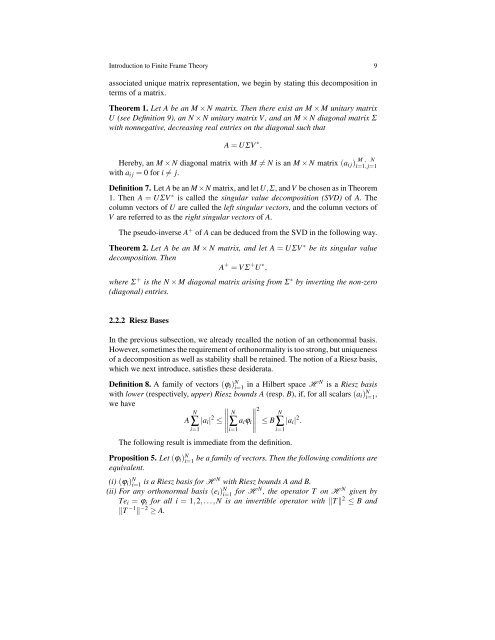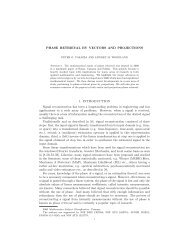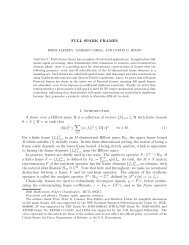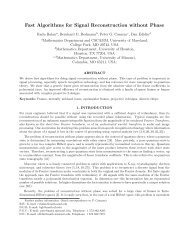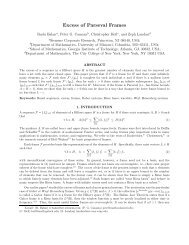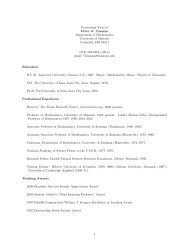Introduction to Finite Frame Theory - Frame Research Center
Introduction to Finite Frame Theory - Frame Research Center
Introduction to Finite Frame Theory - Frame Research Center
Create successful ePaper yourself
Turn your PDF publications into a flip-book with our unique Google optimized e-Paper software.
<strong>Introduction</strong> <strong>to</strong> <strong>Finite</strong> <strong>Frame</strong> <strong>Theory</strong> 9<br />
associated unique matrix representation, we begin by stating this decomposition in<br />
terms of a matrix.<br />
Theorem 1. Let A be an M × N matrix. Then there exist an M × M unitary matrix<br />
U (see Definition 9), an N × N unitary matrix V , and an M × N diagonal matrix Σ<br />
with nonnegative, decreasing real entries on the diagonal such that<br />
A = UΣV ∗ .<br />
Hereby, an M × N diagonal matrix with M ≠ N is an M × N matrix (a i j ) M , N<br />
i=1, j=1<br />
with a i j = 0 for i ≠ j.<br />
Definition 7. Let A be an M ×N matrix, and let U,Σ, and V be chosen as in Theorem<br />
1. Then A = UΣV ∗ is called the singular value decomposition (SVD) of A. The<br />
column vec<strong>to</strong>rs of U are called the left singular vec<strong>to</strong>rs, and the column vec<strong>to</strong>rs of<br />
V are referred <strong>to</strong> as the right singular vec<strong>to</strong>rs of A.<br />
The pseudo-inverse A + of A can be deduced from the SVD in the following way.<br />
Theorem 2. Let A be an M × N matrix, and let A = UΣV ∗ be its singular value<br />
decomposition. Then<br />
A + = V Σ + U ∗ ,<br />
where Σ + is the N × M diagonal matrix arising from Σ ∗ by inverting the non-zero<br />
(diagonal) entries.<br />
2.2.2 Riesz Bases<br />
In the previous subsection, we already recalled the notion of an orthonormal basis.<br />
However, sometimes the requirement of orthonormality is <strong>to</strong>o strong, but uniqueness<br />
of a decomposition as well as stability shall be retained. The notion of a Riesz basis,<br />
which we next introduce, satisfies these desiderata.<br />
Definition 8. A family of vec<strong>to</strong>rs (ϕ i ) N i=1 in a Hilbert space H N is a Riesz basis<br />
with lower (respectively, upper) Riesz bounds A (resp. B), if, for all scalars (a i ) N i=1 ,<br />
we have<br />
∥<br />
N<br />
A∑<br />
|a i | 2 N ∥∥∥∥<br />
2<br />
N<br />
≤<br />
∥∑<br />
a i ϕ i ≤ B∑<br />
|a i | 2 .<br />
i=1<br />
i=1<br />
i=1<br />
The following result is immediate from the definition.<br />
Proposition 5. Let (ϕ i ) N i=1<br />
be a family of vec<strong>to</strong>rs. Then the following conditions are<br />
equivalent.<br />
(i) (ϕ i ) N i=1 is a Riesz basis for H N with Riesz bounds A and B.<br />
(ii) For any orthonormal basis (e i ) N i=1 for H N , the opera<strong>to</strong>r T on H N given by<br />
Te i = ϕ i for all i = 1,2,...,N is an invertible opera<strong>to</strong>r with ‖T ‖ 2 ≤ B and<br />
‖T −1 ‖ −2 ≥ A.


